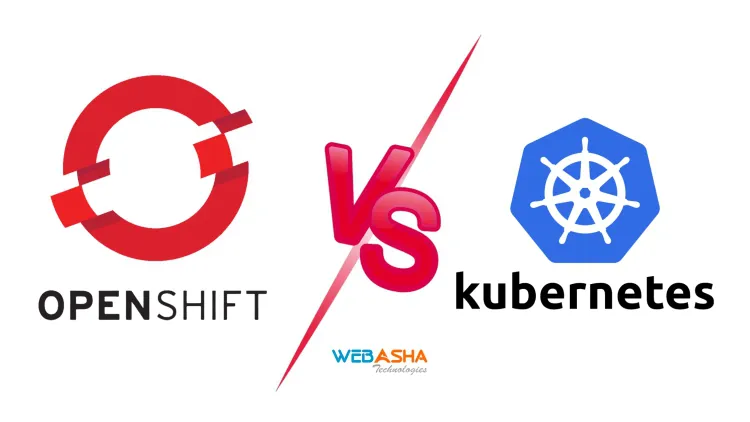Openshift vs. Kubernetes | Which is right for you?
Discover the key differences between OpenShift and Kubernetes. Compare features, ease of use, support, cost, and scalability to find the best container orchestration platform for your needs. Explore which platform suits small businesses and enterprises, and learn when to choose OpenShift or Kubernetes.

The Rise of Container Orchestration: OpenShift vs. Kubernetes
In the dynamic world of software development, innovation and efficiency are the twin pillars driving progress. One technology that has redefined application development and deployment is containerization. With its ability to encapsulate applications and their dependencies into lightweight, portable, and self-sufficient units, containerization has revolutionized how developers build, deploy, and scale applications.
But as organizations increasingly adopt containerized applications, managing these containers effectively at scale has become a pressing challenge. This is where container orchestration tools step in, offering automation, scalability, and operational simplicity. Among these tools, OpenShift and Kubernetes have emerged as leading solutions.
Introduction to Containerization and Its Benefits
At its core, containerization simplifies application deployment by isolating applications and their dependencies in containers. These containers are:
- Portable: They can run seamlessly across different environments, from local machines to cloud platforms.
- Scalable: Containers allow applications to scale horizontally by adding or removing instances based on demand.
- Efficient: Containers share the host operating system’s kernel, making them lightweight and faster to start compared to virtual machines.
These advantages have propelled containerization into the mainstream, enabling developers to build microservices-based architectures and deploy applications faster than ever before.
The Growing Importance of Container Orchestration
While containers bring undeniable benefits, managing them—especially at scale—is no small feat. As applications grow, they require:
- Load balancing to distribute traffic efficiently.
- Automated deployment and updates to ensure reliability.
- Resource management to optimize the use of hardware and minimize costs.
- Monitoring and logging for robust performance and error tracking.
This is where container orchestration tools come in. These tools automate the deployment, scaling, networking, and management of containers, simplifying complex operations for developers and IT teams.
OpenShift and Kubernetes
Two prominent players in the world of container orchestration are Kubernetes, an open-source platform originally developed by Google, and OpenShift, Red Hat’s enterprise-ready Kubernetes distribution. Both are built on similar foundations but offer unique features that cater to different use cases.
But how do these tools compare? Which one is better suited for your container management needs? In this article, we’ll explore the strengths and weaknesses of OpenShift and Kubernetes, helping you make an informed decision.
OpenShift
In the rapidly evolving landscape of container orchestration, OpenShift has distinguished itself as a robust, enterprise-grade platform designed to simplify and enhance the containerized application lifecycle. Developed and supported by Red Hat, OpenShift extends the capabilities of Kubernetes, the widely adopted open-source orchestration platform, by offering enterprise-ready features and additional layers of security, usability, and scalability.
What is OpenShift?
At its core, OpenShift is a Kubernetes distribution tailored for enterprises. While Kubernetes provides the essential building blocks for container orchestration, OpenShift enhances these capabilities with a comprehensive set of tools and services designed to meet the needs of modern development teams and IT organizations.
As a Red Hat product, OpenShift benefits from:
- Professional support services for troubleshooting and optimization.
- Enterprise-level certifications and compliance for secure deployments.
- Seamless integration with Red Hat’s ecosystem of tools, including Red Hat Enterprise Linux (RHEL) and Ansible.
Key Built-In Features of OpenShift
OpenShift differentiates itself with several built-in features designed to streamline workflows, improve efficiency, and enhance security:
-
Developer Console
OpenShift offers an intuitive web-based developer console, making it easier for developers to manage projects, deploy applications, and monitor performance. This user-friendly interface reduces the learning curve associated with Kubernetes while providing robust tools for deployment automation and management. -
Integrated Image Registry
OpenShift includes a built-in image registry, allowing teams to store, manage, and retrieve container images securely. This integrated feature simplifies application deployment by ensuring images are readily available and optimized for use in production environments. -
Integrated Security Tools
Security is a top priority in OpenShift. The platform offers integrated security tools, including:- Role-Based Access Control (RBAC) for managing permissions.
- Container image scanning to detect vulnerabilities.
- Secure networking options, including encryption and network policies, to protect applications from external threats.
-
Automated Operations
OpenShift includes tools for automating routine tasks like scaling, updates, and patching. Features like Operators (specialized software extensions) simplify the management of complex applications by automating operational tasks.
Extensive Support and Community Resources
One of OpenShift’s standout advantages is its extensive support ecosystem. Users have access to:
- Red Hat’s enterprise support team for resolving technical issues and optimizing deployments.
- A rich repository of documentation and tutorials to help teams quickly get up to speed.
- A vibrant community of developers and IT professionals who contribute to OpenShift’s ongoing improvement and provide valuable insights through forums, blogs, and open-source contributions.
Kubernetes
In the world of container orchestration, Kubernetes stands as a pioneer and a benchmark for modern application management. Originally developed and open-sourced by Google, Kubernetes has evolved into a de facto standard for automating the deployment, scaling, and management of containerized applications. Its open-source nature, flexibility, and extensive ecosystem make it one of the most powerful tools for container orchestration.
What is Kubernetes?
Kubernetes, often abbreviated as K8s, is an open-source platform designed to help developers and IT teams manage containerized applications at scale. It automates complex tasks such as:
- Deploying containers across multiple servers.
- Scaling applications based on demand.
- Ensuring applications are resilient to failures through self-healing capabilities.
Flexibility Across Platforms
One of Kubernetes’ most significant strengths is its platform-agnostic nature. Kubernetes can run on a variety of infrastructures, making it incredibly versatile:
- Cloud Providers: Kubernetes integrates seamlessly with leading cloud platforms like Amazon Web Services (AWS), Microsoft Azure, and Google Cloud Platform (GCP).
- On-Premises Infrastructure: For organizations with private data centers, Kubernetes can be deployed on bare-metal servers or virtualized environments.
- Hybrid and Multi-Cloud Setups: Kubernetes allows organizations to run applications across multiple environments, providing flexibility and minimizing vendor lock-in.
This flexibility ensures that Kubernetes meets the diverse needs of enterprises, startups, and everything in between, enabling them to adapt to evolving infrastructure requirements.
A Thriving Community and Ecosystem
Kubernetes is supported by one of the largest and most active open-source communities in the tech world. Its collaborative ecosystem is a significant factor behind its rapid growth and widespread adoption.
-
Vast Community Support
- Kubernetes boasts thousands of contributors worldwide who continually enhance the platform’s capabilities.
- Developers can access a wealth of resources, including forums, GitHub repositories, blogs, and webinars, to troubleshoot and innovate.
-
Extensive Ecosystem of Tools
Kubernetes has spawned a rich ecosystem of third-party tools that complement its core functionalities:- Monitoring and Logging: Tools like Prometheus and Grafana help monitor application performance and system health.
- CI/CD Integration: Jenkins, GitLab, and Tekton integrate seamlessly with Kubernetes for streamlined continuous integration and deployment.
- Service Meshes: Solutions like Istio and Linkerd enhance traffic management and observability within Kubernetes clusters.
- Storage and Networking: Plugins and tools ensure robust storage management and advanced networking configurations.
This ecosystem empowers developers and operations teams to customize Kubernetes deployments to meet their specific needs, creating a tailored environment for building and managing applications.
Choosing the Right Platform: OpenShift vs. Kubernetes
When deciding between OpenShift and Kubernetes, it’s essential to understand the key differences in their features, usability, support, and cost. Below is a comparison table highlighting the core distinctions, followed by recommendations to help you make an informed decision.
Comparison Table
| Feature | Kubernetes | OpenShift |
|---|---|---|
| Ease of Use | Requires more manual setup and configuration. | Offers a user-friendly interface with built-in tools for simplified management. |
| Features | Core container orchestration and scalability. | Built-in developer console, image registry, CI/CD pipelines, and integrated security tools. |
| Support | Open-source community support. | Enterprise-grade support from Red Hat with extensive documentation and resources. |
| Cost | Free to use (self-managed). | Subscription-based pricing for Red Hat support and additional features. |
| Scalability | Highly scalable, depending on the infrastructure setup. | Equally scalable with added automation tools for enterprise environments. |
| Installation | Flexible but may require expertise for setup. | Streamlined installation with pre-configured components. |
| Security | Security must be configured manually. | Advanced built-in security features like RBAC, image scanning, and policy management. |
| Ecosystem | Large third-party tool ecosystem. | Smaller but tightly integrated ecosystem managed by Red Hat. |
| Customization | Highly customizable for diverse needs. | Less flexible due to opinionated design but simplifies operations. |
When to Choose Kubernetes
Kubernetes is ideal for organizations that:
- Need Flexibility: You want to build and manage your own solutions with third-party tools.
- Have In-House Expertise: Your team has the skills to set up and maintain a Kubernetes environment.
- Operate on a Budget: You prefer an open-source platform with no licensing fees.
- Run on Diverse Infrastructure: You plan to deploy across multiple clouds, on-premises, or hybrid setups.
Use Case Example:
A startup with a DevOps team proficient in Kubernetes looking for a cost-effective way to manage containerized applications in a multi-cloud environment.
When to Choose OpenShift
OpenShift is better suited for organizations that:
- Need Enterprise Support: You require professional support for troubleshooting and optimization.
- Want Built-In Features: Your team benefits from a ready-to-use platform with integrated developer tools, CI/CD pipelines, and security features.
- Have a Larger Budget: You can invest in subscription costs for added convenience and enterprise-grade reliability.
- Focus on Developer Productivity: Your developers need an intuitive platform that minimizes operational overhead.
Use Case Example:
An enterprise looking to streamline container management with built-in tools and professional support for deploying and scaling applications across multiple teams.
Conclusion and Recommendation
- Choose Kubernetes if you prioritize flexibility, cost savings, and have a skilled DevOps team capable of managing the complexities of a self-built container orchestration platform.
- Choose OpenShift if you need a comprehensive, enterprise-grade solution with professional support, built-in tools, and minimal configuration to get started quickly.
Both platforms have their strengths, and the choice depends on your organization's specific needs, resources, and goals. By carefully assessing your priorities, you can select the platform that aligns best with your operational and development requirements.
The Future of Container Orchestration
As the backbone of modern IT infrastructure, container orchestration has become indispensable for organizations aiming to deliver applications efficiently and at scale. With the rise of microservices architectures, hybrid cloud deployments, and DevOps practices, platforms like Kubernetes and OpenShift are not just tools but catalysts for innovation and growth.
The Growing Role of Container Orchestration
Container orchestration addresses critical challenges in deploying and managing containerized applications, including automation, scalability, and reliability. By simplifying complex operations, it enables organizations to focus on delivering value to their users. As businesses increasingly adopt cloud-native technologies, container orchestration will remain at the heart of IT transformation.
Future Trends and Advancements
Both Kubernetes and OpenShift continue to evolve, driven by innovation and community contributions. Here’s a glimpse into the future:
-
Enhanced Automation
Future versions of Kubernetes and OpenShift will likely include more advanced automation capabilities, reducing manual intervention for scaling, updates, and troubleshooting. -
AI and Machine Learning Integration
AI-driven orchestration tools may emerge, enabling predictive scaling and intelligent resource allocation based on usage patterns and performance metrics. -
Improved Developer Experience
OpenShift, already focused on simplifying workflows, is likely to introduce more intuitive interfaces and integrations to empower developers. Similarly, Kubernetes might see more third-party tools enhancing user experience. -
Focus on Security
As threats to containerized environments grow, both platforms will prioritize built-in security features, from enhanced image scanning to zero-trust networking. -
Greater Multi-Cloud Support
The push for hybrid and multi-cloud deployments will lead to tighter integrations with diverse cloud providers, offering organizations greater flexibility and resilience.
Making an Informed Decision
The future of container orchestration is promising, but success lies in choosing the right platform for your needs. Whether it’s the flexibility and open-source nature of Kubernetes or the enterprise-grade reliability and features of OpenShift, both platforms are powerful solutions.
FAQ's
-
What are the main differences between OpenShift and Kubernetes?
Kubernetes is an open-source container orchestration platform, while OpenShift is Red Hat’s enterprise-grade Kubernetes distribution with added features like a developer console, integrated security, and CI/CD tools. -
Do I need Kubernetes expertise to use OpenShift?
While Kubernetes knowledge can be helpful, OpenShift simplifies many tasks with its built-in tools and user-friendly interface, making it easier for teams without deep Kubernetes expertise. -
Which platform is better for small businesses: OpenShift or Kubernetes?
Kubernetes might be more cost-effective for small businesses due to its open-source nature, while OpenShift’s enterprise features and support may benefit larger organizations with bigger budgets. -
Is OpenShift only for Red Hat environments?
No, OpenShift can be deployed on multiple platforms, including public clouds like AWS, Azure, and Google Cloud, as well as on-premises and hybrid environments. -
How does the security of OpenShift compare to Kubernetes?
OpenShift includes built-in security features like role-based access control (RBAC), image scanning, and network policies. In Kubernetes, these features require additional configuration or third-party tools. -
Can I run Kubernetes and OpenShift together?
Yes, OpenShift is built on Kubernetes, so they share core functionalities. You can use them together, but OpenShift adds a layer of enterprise tools and features on top of Kubernetes. -
What are the deployment options for OpenShift vs. Kubernetes?
Kubernetes offers flexibility for deployment on any cloud or on-premises infrastructure, while OpenShift provides pre-configured, enterprise-grade solutions with streamlined installation processes. -
Which platform has better community support?
Kubernetes has a vast open-source community with numerous third-party tools and resources, while OpenShift benefits from Red Hat’s enterprise support and documentation alongside a growing community. -
What’s the cost difference between OpenShift and Kubernetes?
Kubernetes is free to use as open-source software, but operational costs (e.g., hosting, support, and tools) can add up. OpenShift requires a subscription fee for Red Hat’s support and additional features but offers a more turnkey solution. -
Which should I choose for my organization: OpenShift or Kubernetes?
Choose Kubernetes if you need flexibility, customization, and cost-efficiency, and have a skilled DevOps team. Opt for OpenShift if you prioritize ease of use, enterprise support, and built-in features that simplify operations.











![Top 10 Ethical Hackers in the World [2025]](https://www.webasha.com/blog/uploads/images/202408/image_100x75_66c2f983c207b.webp)



![[2025] Top 100+ VAPT Interview Questions and Answers](https://www.webasha.com/blog/uploads/images/image_100x75_6512b1e4b64f7.jpg)







